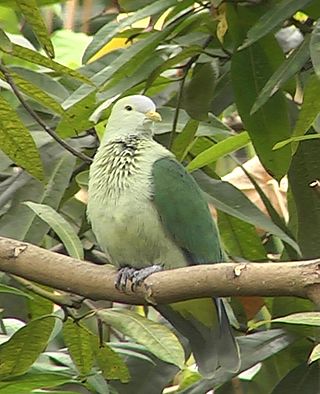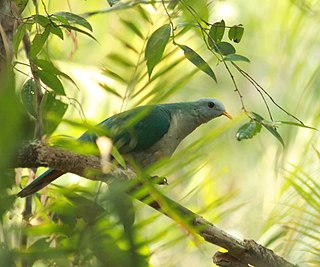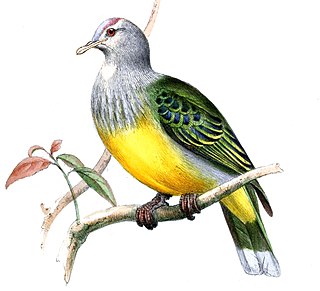
The cloven-feathered dove is a species of bird in the family Columbidae. It is monotypic within the genus Drepanoptila, but this genus is possibly better merged into Ptilinopus. The cloven-feathered dove is endemic to New Caledonia where found in forest and Melaleuca savanna at altitudes up to 1,000 m (3,300 ft).

The Negros fruit dove is a species of bird in the pigeon and dove family, Columbidae. It is endemic to the island of Negros in the Philippines. This fruit dove is known from a single female specimen collected from the slopes of Mount Kanlaon in the northern part of the island. While it was found at a high elevation, it is suspected that the species originally lived in the lowland dipterocarp forests and was driven to higher elevations by habitat destruction. While some have suggested that the specimen is either a runt or a hybrid instead of a valid species, this is not widely accepted. The female Negros fruit dove was a small fruit dove with vivid dark green plumage and an ashy-grey forehead. It had a distinctive ring of bare yellow skin around its eye, and yellow fringes to some of its feathers gave it the appearance of having a yellow wingbar when perched. The throat was white, while the undertail and vent were yellow.

The orange-fronted fruit dove is a species of bird in the family Columbidae., measuring 22-23 cm in length and weighing approximately 136 g. P. aurantiifrons is characterized by a dull green body, a distinctive bright orange forehead, and a gray collar encircling the neck. The female displays duller coloration, and juvenile P. aurantiifrons have not been described.

The atoll fruit dove is a species of bird in the family Columbidae. It is endemic to the Tuamotu archipelago in French Polynesia. Its natural habitats are subtropical or tropical moist lowland forests and plantations. It is threatened by habitat loss.

The white-capped fruit dove, also called kuku locally, is a species of bird in the family Columbidae. It was described by French naturalist and surgeon Adolphe-Simon Neboux in 1840. It is endemic to the Marquesas Islands in French Polynesia. The name honours French admiral and botanist Abel Aubert du Petit-Thouars. Two subspecies exist on the islands, Ptilinopus d. dupetithouarsii and Ptilinopus d. viridior.
The Rapa fruit dove is a species of bird in the family Columbidae, which includes pigeons and doves. It is endemic to the island of Rapa Iti in French Polynesia. The species was classified as Critically Endangered by the IUCN Red List in 2018 because of its small population and predicted continued decline. The Rapa fruit dove primarily feeds on fleshy fruit. Its natural habitat is subtropical or tropical moist lowland forests and it has an extent of 30 km2. It is threatened by habitat loss due to deforestation and invasive species. Effective land protection and management could increase the quality of habitat for the species. Additional research into population dynamics and the impact of threats to the species can give a better understanding of the conservation practices needed.
The Henderson fruit dove, Henderson Island fruit dove or scarlet-capped fruit dove is a species of bird in the family Columbidae.

The red-moustached fruit dove or moustached fruit dove is an extinct species of bird in the family Columbidae. It was endemic to French Polynesia. The last record was of the subspecies P. m. tristrami on Hiva Oa, in 1922. Its extinction has been attributed to predation by the introduced great horned owl, as well as by introduced rats and cats. In 1994, it was listed as an extinct species on the International Union for Conservation of Nature Red List of Endangered Species.

The cream-breasted fruit dove or cream-bellied fruit dove is a species of bird in the family Columbidae. It is a large and primarily greenish dove with a distinctive red wing patch and cream coloured breast which it was named after. It is endemic to the Philippines found only on the islands of Luzon, Catanduanes and Polillo Islands. Its natural habitat is tropical moist lowland to montane forests of up to 1,300 masl. It is threatened by habitat loss, and trapping for the pet trade.

The dwarf fruit dove is a species of bird in the family Columbidae. It is found in lowland and foothill forest in New Guinea and the Raja Ampat Islands.The dwarf fruit dove weighs 49 grams, about equivalent to the weight of two AA batteries. This bird is the smallest in length of the fruit dove genus.

The yellow-breasted fruit dove locally known as balorinay is a species of bird in the family Columbidae. It is endemic to the Philippines. Its natural habitat is tropical moist lowland forest. While it is listed as least concern in IUCN, it is declining due to habitat loss, hunting, and trapping for the illegal wildlife trade.

The grey-green fruit dove is a species of bird in the family Columbidae. It is endemic to the Society Islands in French Polynesia. Its natural habitat is subtropical or tropical moist lowland forests.

The white-bibbed fruit dove is a species of bird in the family Columbidae.
The Tanna fruit dove is a species of bird in the family Columbidae. It is endemic to Vanuatu.

The Banggai fruit dove, also called maroon-chinned fruit dove is a species of bird in the family Columbidae. It is endemic to the Banggai Islands. Its natural habitat is subtropical or tropical moist lowland forests. It is threatened by habitat loss.

The fruit doves, also known as fruit pigeons, are a genus (Ptilinopus) of birds in the pigeon and dove family (Columbidae). These colourful, frugivorous doves are found in forests and woodlands in Southeast Asia and Oceania. It is a large genus with over 50 species, some threatened or already extinct.

The Raiatea fruit dove is a species of bird in the family Columbidae. It is endemic to the Society Islands in French Polynesia. Although first named to science in 1853, this fruit dove was evidently discovered 30 years earlier, by René Primevère Lesson (1794–1849), while serving as naturalist aboard La Coquille. It was formerly considered a subspecies of the grey-green fruit dove but was split as a distinct species by the IOC in 2021. Its natural habitat is subtropical or tropical moist lowland forests.

The Tuamotu tropical moist forests is a tropical and subtropical moist broadleaf forests ecoregion in the Tuamotu Archipelago of French Polynesia and the Pitcairn Islands.
















